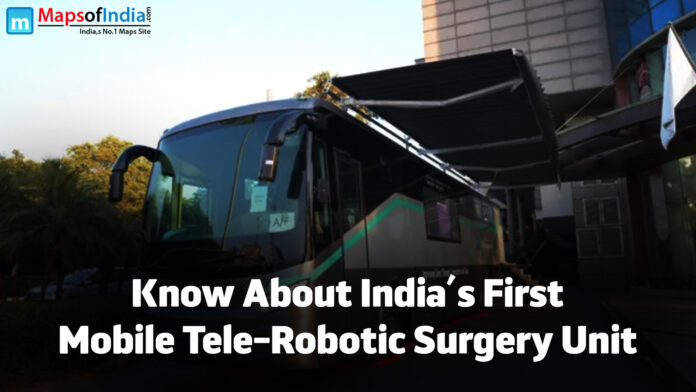Healthcare has made tremendous progress in recent decades, and technology is fostering patient care, accessibility, and surgery in the medical domain. India, which is already at the forefront of innovative medicines and medical technology, takes another step forward as the country introduces its very first mobile telerobotic surgery unit. This innovative framework can transform operative care delivery in rural and underserved regions, allowing surgeons to deliver surgical services at the patient’s doorstep.
In a country where the majority of the population has limited access to proper health care, the mobile telerobotic surgery unit is nothing less than a revolution. This article covers all the aspects of this innovation, its impact, hurdles, and the future of robotic surgery in India.
What is a Mobile Tele-Robotic Surgery Unit?
A mobile telerobotic surgery unit refers to a PCI device equipped with a gynaecology robot mounted on a specialised mobile platform (a vehicle or a van specially designed for mobile surgical applications). The unit enables skilled surgeons to remotely conduct demanding operations through robotic arms linked to Wi-Fi internet at thousandths. The mobile unit travels to remote or underdeveloped areas, bringing surgical care to people in those regions without needing to travel to a hospital in a large city.
This technological wonder combines robotic-assisted surgery, telemedicine, artificial intelligence (AI), and 5G-enabled communication to facilitate real-time joint surgery between on-site medical personnel and off-site surgeons. Using HD cameras and real-time imaging capabilities, along with robotic arms that mirror a surgeon’s careful touch, this mobile surgical unit is a one-stop shop for immaculate surgical precision.
The Driving Force Behind the Initiative
This technological wonder combines robotic-assisted surgery, telemedicine, artificial intelligence (AI), and 5G-enabled communication to facilitate real-time joint surgery between on-site medical personnel and off-site surgeons. Using HD cameras and real-time imaging capabilities, along with robotic arms that mirror a surgeon’s careful touch, this mobile surgical unit is a one-stop shop for immaculate surgical precision.
The launch of India’s first mobile telerobotic surgery unit, resulting from a partnership between the government, private healthcare providers and technological corporations, aims to bridge the healthcare gap between rural and urban India. There are a few reasons as to why something like such an innovation is required:
- Healthcare Disparities: Most of India’s rural population does not have access to specialised medical facilities, making it necessary for patients to travel long distances to get surgery.
- Surgeons Not Only are Limited in Number: Skilled surgeons shy away from moving to rural areas, depleting these centres of trained and qualified professionals, and, hence, there is an uneven distribution of surgeons, with most of the trained surgeons sitting in metropolitan cities.
- Technology Developments: An increase in robotic-assisted surgery and the emergence of high-speed 5G networks make remote surgeries more possible than ever.
- Government and Private Sector Support: The Indian healthcare technology sector is experiencing a shift towards smart healthcare solutions with a higher investment in healthcare technology.
How Does Mobile Tele-Robotic Surgery Unit Work?
The hub-and-spoke model of the mobile unit works such that a mobile surgical unit can be (spokes) linked to a central command centre (hub). Here’s how the process works:
- Pre-Surgical Assessment: Patients are pre-screened and assessed over time with telemedicine consultations before scheduling a robotic-assisted procedure.
- Mobile Unit Organisation: The mobile unit is deployed to the patient’s location , and a trained medical team performs the procedure.
- Tele-Surgical Operation: The surgery is performed remotely by a surgeon from a leading hospital using a robotic surgical console.
- Latency: The system uses high-speed internet, AI-enhanced diagnostics and robotic precision to perform the surgery in real-time.
- Post-Operative Care: Mobile units visit patients at their homes to monitor them after the surgery, conducting follow-up consultations via telemedicine.
Potential Benefits of the Mobile Tele-Robotic Surgery Unit
The innovation has profound implications and is advantageous for patients and healthcare workers . Here are some of the most essential benefits:
- Bridging the Healthcare Divide Between Rural and Urban Areas: This enables us to reach even the most remote villages and provide world-class surgical care without needing long-distance travel.
- Improving the Accuracy and Safety of Surgery: Robotic-assisted surgeries can undergo much less invasive procedures, limiting complications, hospital stays, and recovery time.
- The Benefits of Urban Hospital System Relief: Decentralising surgical services will alleviate urban overcrowding, leading to optimal resource allocation.
- Bringing Expert Surgeons to the Masses: Accomplished surgeons can remotely operate on multiple patients at different places, increasing their productivity.
- Improved Emergency Response to Medical Emergencies: For example, the mobile unit can be quickly deployed in areas affected by natural disasters, humanitarian conflicts or pandemics to provide surgical intervention.
- Cost-Effective Healthcare Solutions: This system reduces transportation and hospitalisation costs while increasing patient access to advanced surgical care.
Challenges and Limitations
Although a revolutionary concept, the mobile tele-robotic surgery unit has significant challenges:
- Connectivity Issues: Remote regions frequently grapple with less dependable high-speed internet, essential for smooth robotic-assisted procedures.
- High Initial Investment: Establishing and sustaining these mobility units requires substantial public and private investments.
- Workforce Adaptation and Training: Doctors must be trained not only for robotic systems but also to adapt to remote surgical techniques.
- Legal and Ethical Concerns: The regulators should formulate guidelines for the government regarding liability, patient consent and data security in remote robotic surgeries.
- Power Supply and Infrastructure: Many rural areas still experience intermittent power supply, which can jeopardise the functioning of the equipment.
Future Prospects
Mobile telerobotic surgery is not far behind in India, which has a bright future that can be expected with numerous leaps from the various frontiers in the coming years:
- Expansion of Network: More mobile units across the length and breadth of India
- AI and Machine Learning in Surgical Procedures: Predictive analytics and AI-powered diagnostic tools will also improve surgical outcomes.
- Government Incentives and Funding: The government can also play a key role in enhancing research and development in this sector, further increasing public-private partnerships that will lead to better funding for the expansion of this initiative.
- International Collaboration: India can partner with global healthcare leaders and introduce robotic technology.
- Cost Efficient and Scalable Solutions: Over time, these units could become more affordable, allowing advanced surgical treatment to be available to a wider population.
Conclusion
Establishing India’s first Mobile Tele-Robotic Surgery Unit is a major stride toward making healthcare accessible across the country. The company aims to revolutionise surgery and ensure that every person, regardless of geographic location or socioeconomic status, will have access to the same healthcare offered in major cities.
As technology advances, mobile robotic surgery units could become a common sight in India’s healthcare ecosystem in the future. Despite challenges, the rewards greatly outweigh the obstacles, promising a time when geographical barriers will no longer leave any patient behind. India is poised to lead global telerobotic surgical innovation, revolutionising modern healthcare as we know it through sustained investment, training, and technological advancements.




